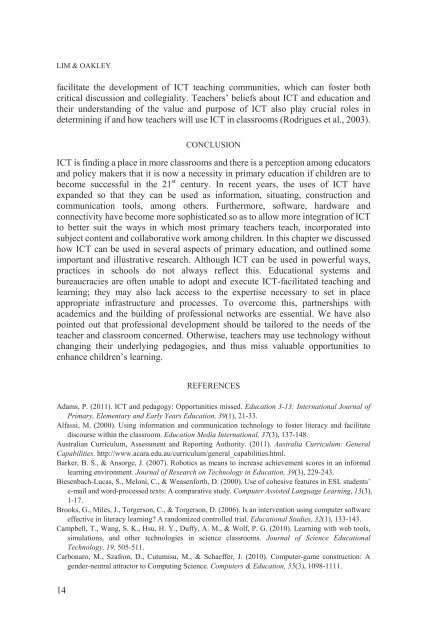1517-creating-holistic-technology-enhanced-learning-experiences
1517-creating-holistic-technology-enhanced-learning-experiences
1517-creating-holistic-technology-enhanced-learning-experiences
Create successful ePaper yourself
Turn your PDF publications into a flip-book with our unique Google optimized e-Paper software.
LIM & OAKLEY<br />
facilitate the development of ICT teaching communities, which can foster both<br />
critical discussion and collegiality. Teachers’ beliefs about ICT and education and<br />
their understanding of the value and purpose of ICT also play crucial roles in<br />
determining if and how teachers will use ICT in classrooms (Rodrigues et al., 2003).<br />
14<br />
CONCLUSION<br />
ICT is finding a place in more classrooms and there is a perception among educators<br />
and policy makers that it is now a necessity in primary education if children are to<br />
become successful in the 21 st century. In recent years, the uses of ICT have<br />
expanded so that they can be used as information, situating, construction and<br />
communication tools, among others. Furthermore, software, hardware and<br />
connectivity have become more sophisticated so as to allow more integration of ICT<br />
to better suit the ways in which most primary teachers teach, incorporated into<br />
subject content and collaborative work among children. In this chapter we discussed<br />
how ICT can be used in several aspects of primary education, and outlined some<br />
important and illustrative research. Although ICT can be used in powerful ways,<br />
practices in schools do not always reflect this. Educational systems and<br />
bureaucracies are often unable to adopt and execute ICT-facilitated teaching and<br />
<strong>learning</strong>; they may also lack access to the expertise necessary to set in place<br />
appropriate infrastructure and processes. To overcome this, partnerships with<br />
academics and the building of professional networks are essential. We have also<br />
pointed out that professional development should be tailored to the needs of the<br />
teacher and classroom concerned. Otherwise, teachers may use <strong>technology</strong> without<br />
changing their underlying pedagogies, and thus miss valuable opportunities to<br />
enhance children’s <strong>learning</strong>.<br />
REFERENCES<br />
Adams, P. (2011). ICT and pedagogy: Opportunities missed. Education 3-13: International Journal of<br />
Primary, Elementary and Early Years Education, 39(1), 21-33.<br />
Alfassi, M. (2000). Using information and communication <strong>technology</strong> to foster literacy and facilitate<br />
discourse within the classroom. Education Media International, 37(3), 137-148.<br />
Australian Curriculum, Assessment and Reporting Authority. (2011). Australia Curriculum: General<br />
Capabilities. http://www.acara.edu.au/curriculum/general_capabilities.html.<br />
Barker, B. S., & Ansorge, J. (2007). Robotics as means to increase achievement scores in an informal<br />
<strong>learning</strong> environment. Journal of Research on Technology in Education, 39(3), 229-243.<br />
Biesenbach-Lucas, S., Meloni, C., & Weasenforth, D. (2000). Use of cohesive features in ESL students’<br />
e-mail and word-processed texts: A comparative study. Computer Assisted Language Learning, 13(3),<br />
1-17.<br />
Brooks, G., Miles, J., Torgerson, C., & Torgerson, D. (2006). Is an intervention using computer software<br />
effective in literacy <strong>learning</strong>? A randomized controlled trial. Educational Studies, 32(1), 133-143.<br />
Campbell, T., Wang, S. K., Hsu, H. Y., Duffy, A. M., & Wolf, P. G. (2010). Learning with web tools,<br />
simulations, and other technologies in science classrooms. Journal of Science Educational<br />
Technology, 19, 505-511.<br />
Carbonaro, M., Szafron, D., Cutumisu, M., & Schaeffer, J. (2010). Computer-game construction: A<br />
gender-neutral attractor to Computing Science. Computers & Education, 55(3), 1098-1111.


